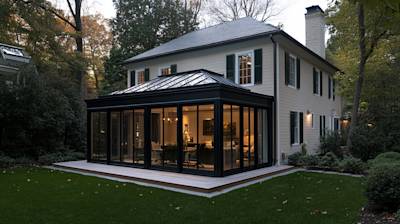ADU Laws in California
Understanding ADUs in California: Laws and Regulations Explained
Accessory Dwelling Units (ADUs), also known as secondary units, granny flats, or in-law units, have gained popularity in California due to their potential to provide affordable housing options. ADU laws in California are designed to streamline the process of building these units. These laws cover aspects such as size, location, and occupancy requirements, ensuring that ADUs contribute positively to the state's housing crisis.
Definition and Purpose of ADUs
An ADU is a secondary housing unit on a single-family residential lot. The purpose of ADUs is to create more affordable housing options in urban and suburban areas. ADU laws in California have been updated to make it easier for homeowners to build these units.
Benefits of ADUs in California:
- Increasing housing affordability for renters and homeowners.
- Providing a source of rental income for homeowners.
- Supporting multigenerational living arrangements.
- Reducing urban sprawl and promoting sustainable development.
Recent Changes and Updates to ADU Laws in California
The state of California has recently implemented significant changes to ADU regulations, aiming to reduce barriers and simplify the approval process for homeowners. These changes include reducing setback requirements, waiving certain fees, and streamlining the permitting process.
Impact on Homeowners
These updates have a profound impact on homeowners, making it more feasible to add an ADU to their property, thus potentially increasing the value and utility of their property.
Key Recent Changes to ADU Laws:
- Reduction in minimum lot size requirements.
- Relaxation of parking space requirements.
- Waiver of utility connection fees in some cases.
- Streamlined permit processing timelines.
Zoning and Land Use Regulations for ADUs in California
Zoning laws play a crucial role in determining where ADUs can be built. In California, recent laws have aimed to relax zoning restrictions to accommodate more ADUs, especially in residential areas.
Local Zoning Ordinances
Despite state laws, local zoning ordinances in Sacramento and other areas can have specific requirements. It’s essential for homeowners to check with local planning departments to understand these unique requirements.
Key Zoning Considerations:
- Zoning district compatibility for ADUs.
- Setback and yard requirements.
- Maximum ADU size limitations.
- Height restrictions.
Building Codes and Permitting Requirements for ADUs in California
Building codes and permitting requirements are critical aspects of ADU development. These codes ensure that ADUs are safe and habitable. The permitting process, though streamlined, still requires careful attention to detail.
Permitting Process
The permitting process for ADUs in California involves submitting detailed plans and undergoing inspections. This process ensures that the ADU meets all safety and building standards.
Steps in the Permitting Process:
- Consultation with local building department.
- Submission of architectural plans and engineering documents.
- Review and approval by the building department.
- Inspections during construction phases.
- Final inspection and issuance of a certificate of occupancy.
ADU Design and Size Requirements in California
The design and size of ADUs in California are subject to specific standards. These standards dictate the maximum size, height, and design elements of ADUs, ensuring they are compatible with existing neighborhood character.
Customizing Your ADU
While adhering to these requirements, homeowners can work with a professional ADU building contractor like Solid Construction & Design to customize their ADUs to suit their specific needs and aesthetic preferences.
Design Considerations:
- Architectural styles and aesthetics.
- Interior layout and functionality.
- Energy-efficient features and sustainability.
- Accessibility for all occupants.
How to Get Started: Steps to Comply with ADU Laws and Regulations
Getting started with your ADU project involves understanding the local and state regulations, designing your ADU, obtaining permits, and choosing the right contractor for construction.
Choosing the Right Contractor
Selecting a professional ADU builder with experience in Sacramento is crucial for a successful project. Solid Construction & Design offers expertise in navigating local regulations and delivering high-quality ADUs.
Steps to Get Started:
- Research local and state ADU regulations.
- Consult with a design professional to create ADU plans.
- Visit your local permitting department to understand requirements.
- Hire a reputable ADU contractor with experience.
- Secure financing for your ADU project.
Maximizing Your ADU Potential: Key Considerations in California
Maximizing the potential of your ADU involves considering factors like design, location, and the target demographic for renting. Thoughtful planning can turn your ADU project into a profitable investment.
Factors for Maximizing ADU Potential:
- Location and accessibility to amenities.
- Design features that cater to potential tenants.
- Market research on rental demand in your area.
- Proper marketing and tenant screening processes.
Legalizing Existing ADUs: Navigating Retroactive Compliance
For homeowners with existing, unpermitted ADUs, understanding how to navigate retroactive compliance is essential. This may involve upgrading the unit to meet current building codes and obtaining the necessary permits.
Retroactive Compliance Steps:
- Assessment of your existing ADU's condition.
- Consultation with a building inspector to identify deficiencies.
- Development of a compliance plan and budget for necessary upgrades.
- Obtaining the required permits and completing renovations.
- Final inspection to ensure compliance with current codes.
ADU Financing and Incentives in California
Financing an ADU project can be challenging, but there are various incentives and financing options available in California. These include loans, grants, and fee waivers, designed to encourage ADU construction.
ADU Financing Options:
- Home equity loans or lines of credit.
- ADU-specific loans and construction financing.
- Government grants and subsidies for affordable housing.
- Fee waivers and tax incentives for ADU construction.
Potential Future Changes to ADU Laws and Regulations in California
As the housing crisis evolves, so too may ADU laws and regulations in California. Staying informed about potential future changes is crucial for homeowners and investors.
Anticipated Future Changes:
- Continued efforts to streamline permitting processes.
- Adjustments to ADU size and design requirements.
- Exploration of additional incentives for ADU construction.
- Monitoring of ADU's impact on housing affordability.
Common Challenges and Solutions for ADU Owners in California
ADU owners in California may face challenges such as navigating complex regulations, managing construction costs, and dealing with neighborhood opposition. Working with experienced professionals like Solid Construction & Design can help mitigate these challenges.
Challenges and Solutions:
- Challenge: Meeting all zoning and building code requirements.
- Solution: Consult with experts and hire experienced contractors.
- Challenge: Managing construction costs within budget.
- Solution: Get multiple quotes, plan cost-effective designs.
- Challenge: Addressing neighborhood concerns and opposition.
- Solution: Engage with neighbors, address their concerns, and comply with regulations.
In conclusion, understanding and complying with ADU laws and regulations in California is vital for homeowners and investors. With the right guidance and expertise, ADUs can provide a valuable addition to your property and contribute to solving the housing crisis in California.












